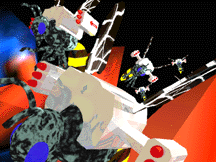| BIOWAR : 1994 | |
|---|---|

|
|

| BIOWAR : 1994 | |
|---|---|

|
|

Biowar was one of the first attempts at animation, traditional or otherwise. Prior to this I had no knowledge of attitudes such as timing, expressions, characterization, or any other aspect of animation that makes it such an amazing and quite fascinating field of study and exploration. It did however instill in me a desire to explore this medium more and more and frankly become a student of it.
The story revolves around a theme I had toyed with in high school. Originally, it was deemed a test in creating a four-panel storyboard. I concocted a story set around the pollination activities of a standard bee. The twist of it was that I set these characters were set in a futuristic neo-apocalyptic world where everything is barren and the insects have assimilated warlike equipment: helmets, missile launchers, jet packs, etc... The insects have all joined forces and created squadron like activities in which they patrol areas and lead bombing runs to re-juvinate "dead zones" (non fertile regions).
This particular story is of one such "bombing run". The bees patrol a certain "dead zone" and report back to a bombing inscect: in this case a butterfly. With it's massive wings and appendages holding onto a "pollen bomb", it swoops into a targeted location and releases it's bomb onto the selected location. Similar to a nuclear bomb, the weapon unleashes it's effects on the surrounding environment. The difference this time derives in the actual affect. The surrounding environment instead of being left a barren wasteland of sorts is transformed into a re-juvinated, and strikingly colorful landscape. The land appears fertile and full of life (hope) where once it was desolate and bare.
Music was provided by Rimsky-Korsakov's "Flight Of The Bumblebee".
This particular frame (not from the final animation, but a test render), was used in a stereographic imaging project. The scene was rendered as it currently is depicted. Then the camera was shifted a small amount, and then re-rendered. The two frames were then made into slides. These slides were then put in a sort of "view finder" contraption that contained polarized lenses. The image within the "view finder" merged into one image and produced a three dimensional effect. the nearer insect would appear to jump out at the viewer much like a cheap 3D movie would.
It would be safe to say that this was my first attempt at "virtual reality"...